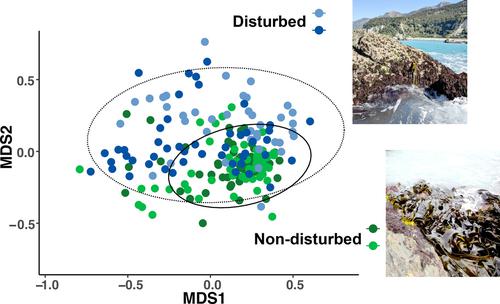当前位置:
X-MOL 学术
›
Environ. Microbiol.
›
论文详情
Our official English website, www.x-mol.net, welcomes your
feedback! (Note: you will need to create a separate account there.)
Host population crashes disrupt the diversity of associated marine microbiomes
Environmental Microbiology ( IF 4.3 ) Pub Date : 2024-03-23 , DOI: 10.1111/1462-2920.16611 William S Pearman 1, 2, 3 , Sergio E Morales 2 , Felix Vaux 3, 4 , Neil J Gemmell 5 , Ceridwen I Fraser 1
Environmental Microbiology ( IF 4.3 ) Pub Date : 2024-03-23 , DOI: 10.1111/1462-2920.16611 William S Pearman 1, 2, 3 , Sergio E Morales 2 , Felix Vaux 3, 4 , Neil J Gemmell 5 , Ceridwen I Fraser 1
Affiliation

|
Host‐associated microbial communities are shaped by myriad factors ranging from host conditions, environmental conditions and other microbes. Disentangling the ecological impact of each of these factors can be particularly difficult as many variables are correlated. Here, we leveraged earthquake‐induced changes in host population structure to assess the influence of population crashes on marine microbial ecosystems. A large (7.8 magnitude) earthquake in New Zealand in 2016 led to widespread coastal uplift of up to ~6 m, sufficient to locally extirpate some intertidal southern bull kelp populations. These uplifted populations are slowly recovering, but remain at much lower densities than at nearby, less‐uplifted sites. By comparing the microbial communities of the hosts from disturbed and relatively undisturbed populations using 16S rRNA gene amplicon sequencing, we observed that disturbed host populations supported higher functional, taxonomic and phylogenetic microbial beta diversity than non‐disturbed host populations. Our findings shed light on microbiome ecological assembly processes, particularly highlighting that large‐scale disturbances that affect host populations can dramatically influence microbiome structure. We suggest that disturbance‐induced changes in host density limit the dispersal opportunities of microbes, with host community connectivity declining with the density of host populations.
中文翻译:

宿主种群崩溃破坏了相关海洋微生物组的多样性
与宿主相关的微生物群落是由宿主条件、环境条件和其他微生物等多种因素决定的。由于许多变量都是相关的,因此理清每个因素对生态的影响可能特别困难。在这里,我们利用地震引起的宿主种群结构的变化来评估种群崩溃对海洋微生物生态系统的影响。 2016 年新西兰发生的一场大地震(7.8 级)导致海岸大面积隆起高达约 6 m,足以局部消灭一些潮间带南部的巨藻种群。这些隆起的人口正在缓慢恢复,但其密度仍然比附近隆起程度较低的地点低得多。通过使用 16S rRNA 基因扩增子测序比较受干扰和相对未受干扰群体的宿主微生物群落,我们观察到受干扰的宿主群体比未受干扰的宿主群体支持更高的功能、分类和系统发育微生物 β 多样性。我们的研究结果揭示了微生物组生态组装过程,特别强调影响宿主种群的大规模干扰可以极大地影响微生物组结构。我们认为,干扰引起的宿主密度变化限制了微生物的扩散机会,宿主群落的连通性随着宿主种群密度的增加而下降。
更新日期:2024-03-23
中文翻译:

宿主种群崩溃破坏了相关海洋微生物组的多样性
与宿主相关的微生物群落是由宿主条件、环境条件和其他微生物等多种因素决定的。由于许多变量都是相关的,因此理清每个因素对生态的影响可能特别困难。在这里,我们利用地震引起的宿主种群结构的变化来评估种群崩溃对海洋微生物生态系统的影响。 2016 年新西兰发生的一场大地震(7.8 级)导致海岸大面积隆起高达约 6 m,足以局部消灭一些潮间带南部的巨藻种群。这些隆起的人口正在缓慢恢复,但其密度仍然比附近隆起程度较低的地点低得多。通过使用 16S rRNA 基因扩增子测序比较受干扰和相对未受干扰群体的宿主微生物群落,我们观察到受干扰的宿主群体比未受干扰的宿主群体支持更高的功能、分类和系统发育微生物 β 多样性。我们的研究结果揭示了微生物组生态组装过程,特别强调影响宿主种群的大规模干扰可以极大地影响微生物组结构。我们认为,干扰引起的宿主密度变化限制了微生物的扩散机会,宿主群落的连通性随着宿主种群密度的增加而下降。











































 京公网安备 11010802027423号
京公网安备 11010802027423号